Repetitive Strain Injury And 4 Ways To Prevent It
by Dylan Kerkes on Apr 8, 2021 10:30:00 AM

The forearms are the work horses of the modern-day warrior. From texting to typing to clicking things on the internet we are constantly using the intricate muscles and tendons of the lower arm. This modern 24/7 demand of our tissues has developed painful conditions known as a repetitive strain injury.
These syndromes are the result of overuse and not taking the proper care of our hands and forearms.
Like driving a car without doing an oil change, eventually the muscles/tendons you use every day are going to break without the proper maintenance. Luckily for us however, there are several things you can do to hack the modern demands of technology and keep those hands functioning well into your golden years.
The Problem:
Repetitive Strain Injury (RSI)
Like many things in life the lower half of your arm needs routine maintenance to function long-term. Professions ranging from accountant to engineer to cook all require intense use of the hands which connect to the tendons and muscles of the forearms. In addition to the daily work we do, our hands and thumbs are constantly being used through the modern way of communicating: texting. If you leave 8 hours for sleep (hopefully you aren’t txting ppl in ur …) that leaves 16 hours spent utilizing your hands from cooking breakfast to working to texting friends about what to do for dinner. Your lower arms are basically running a 16-hour marathon every day!
Clearly overuse is easy to achieve, so what do RSI symptoms look like?
- Hot Spots - tender areas of the forearm, painful to the touch
- Burning/aching
- Weakness – hard to complete simple tasks
- Early signs include soreness, tingling or discomfort.
Carpal Tunnel
Carpel Tunnel is defined by WebMD as a syndrome of numbness, tingling, weakness, and other problems in your hand because of pressure (compression) on the median nerve in your wrist. The pressure can result from bad posture or from RSI related swelling. The most common choke point is when your wrist is flexed. But don’t focus just on the wrist; the problem can be traced all the way up your body. By rounding the shoulders forward and craning the neck towards your monitor you’re adding “kinks to the hose.” Compressive forces on the bundle of nerves (the hose) running up your arm.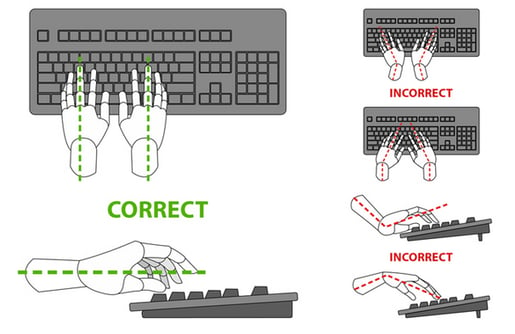
Figure 1: Correct Typing Wrist Position
De Quervain's Tenosynovitis (Text Thumb)
Falling under the RSI category of issues, the abuse of the thumb for activities such as texting and scrolling through emails on your phone has created an overuse syndrome deemed “text thumb.” This condition is defined by the swelling of the thumb tendon from repetitive motion.
Now let’s move into some preventative measures to avoid these conditions.
Devices
Ergonomic Mouse:
The shape of this mouse rotates your hand into a “thumb up” neutral position. When using a conventional mouse your hands are rotated palm facing downward which puts additional stress on the ligaments and tendons of the wrist and fingers. This improper positioning can create the compressive forces that cause RSI and carpal tunnel. While infrequent use of this position will not hurt you, extended time frames: 8 hours per day, 40 plus hours a week is when the stress can add up and lead to various syndromes. The rotation of the mouse to the thumb up position, also places your shoulder into a better biomechanical position, reducing the “kinks in the hose” upstream of your arm.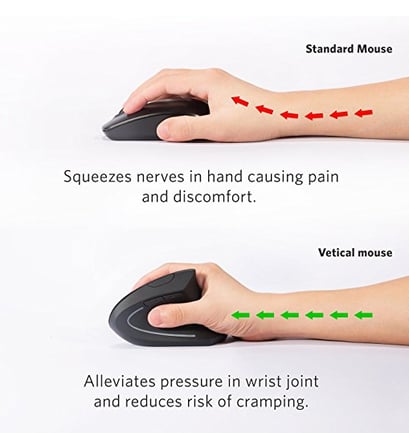
Figure 3: Anker® Ergonomic Mouse
PopSockets
This handy device sticks to the back of your phone and takes the stress off your fingers when using your phone. Similar to the mouse concept, short periods of time using your phone conventionally will not hurt you. It’s the extended periods of time using your phone that can lead to RSI.
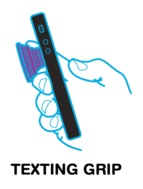

Figure 4: PopSocket
Self-Massage
Apart from the biohacks above, one of the best ways to prevent muscle and tendon strain is regular massage work of the affected areas. By doing the following mobility exercises a few times a week, you can prevent the overuse conditions from appearing.
Forearms
A cheap way to loosen up the Slim Jims’ that are your forearm, is by taking two lacrosse balls with your arm in between and use them to effectively massage your forearm:
Step 1:
Place lacrosse ball on raised surface.
Step 2:
Place arm on lax ball palm facing upwards. Take the ball in your other hand and use both balls to massage the entire length of your forearm. Use similar techniques to massage such as pressure wave (varying the amount of force on the top lax ball), rotation (applying pressure and rotating the ball using the “sticky” surface to grab skin), and broad circular motion (move the entire ball/hand in rotation rather than the previous method of rotating the ball). Spend at least 2 minutes in this position.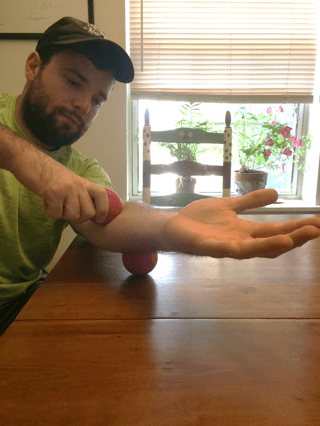
Figure 5: Palm Up Position
Step 3:
Flip your hand and arm and repeat step 2. Go for at least 2 minutes (the required time to make changes in tissue).
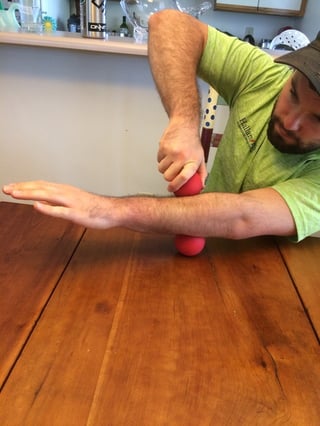
Figure 6: Palm Facing Down Position
Next we will tackle the lower arm.
Thumb and Hand
Have a highlighter handy? In addition to the ability to paint words neon, you can use it as a mobility device! It fits well in the thumb and hand region.
Step 1:
Place cap end of highlighter on thumb pad.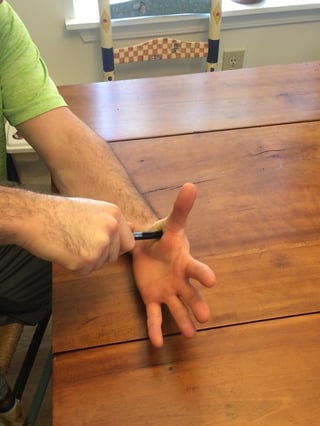
Figure 7: Location of Highlighter on Thumb Pad
Step 2:
Apply Pressure and circle thumb (both directions).
Step 3:
Take the highlighter to the opposite side of your hand.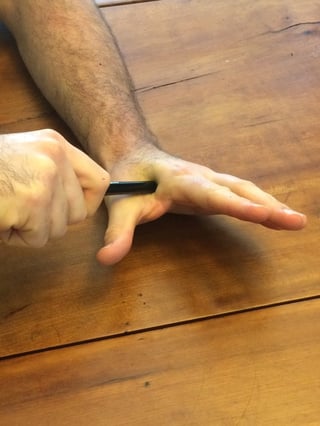
Figure 8: Alternate Position
Step 4:
Apply pressure and rotate thumb (both directions).
Finally, if you’re a mobility nerd like me there’s a convenient device that wraps these movements into an easy to use torture mechanism.
Armaid
If you’re looking for one device that can do it all while you’re watching TV, look no further than the Armaid. While it may get some head turns if used in public this device is great for working the forearms and thumb area (also can be used to massage the triceps and bicep).
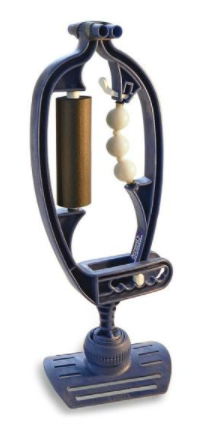
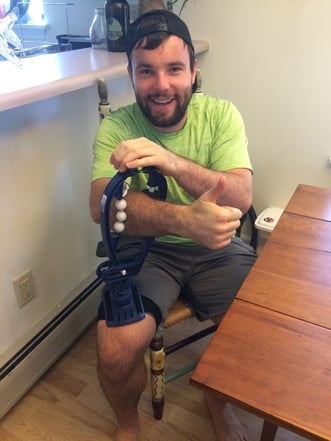
Figure 9: Me Posing Proudly With My Armaid
Conclusion
As with any health issue its best to consult your doctor for any existing pain. The purpose of this article is to highlight the issues, causes, and some preventative options to avoid conditions related to RSI. Depending on your daily activity you can opt to do all of these things or just a few. For the massage techniques; depending on the severity of tightness in your forearms, you can do these exercises 3 times a week until your muscles and tendons loosen. From there weekly maintenance may be all that’s required. That’s right 16 minutes a week (2 minutes top and bottom of forearm and thumb) is all it takes to potentially avoiding surgery down the line. It is important to realize that working at a computer all day is not what we are biologically made to do. The human body however, is great at adapting. Adopting some of these “biohacks” into your daily life can keep you both healthy and employed!
Links and References
Starrett, Kelly, Juliet Starrett, and Glen Cordoza. Deskbound: Standing up to a Sitting World. Las Vegas, NV: Victory Belt, 2016. Print.
Armaid:
Anker Mouse:
https://www.amazon.com/Anker-Wireless-Vertical-Ergonomic-Optical/dp/B00BIFNTMC
PopSocket:
https://www.mobilitywod.com/product/popsockets/
About the Author
Dylan is a driven Mechanical Engineer with experience in both design and project management. He is a graduate of Rensselaer Polytechnic Institute with B.S. in Mechanical Engineering. Dylan holds a 3rd degree black belt in Kenpo Jujitsu. He has coached individuals in self-defense as well as strength/conditioning and mobility.
Read My Hallam Story
About Hallam-ICS
Hallam-ICS is an engineering and automation company that designs MEP systems for facilities and plants, engineers control and automation solutions, and ensures safety and regulatory compliance through arc flash studies, commissioning, and validation. Our offices are located in Massachusetts, Connecticut, New York, Vermont and North Carolina and our projects take us world-wide.
You May Also Like
These Related Stories

Industrial Sensor Data Integration with Ignition

Inspired Engineering – Things I learned in My First Hallam Year



No Comments Yet
Let us know what you think